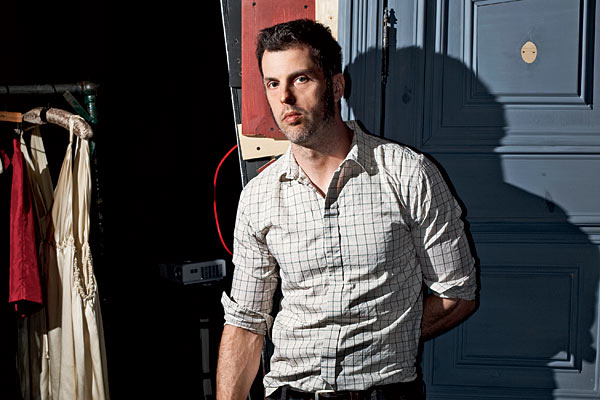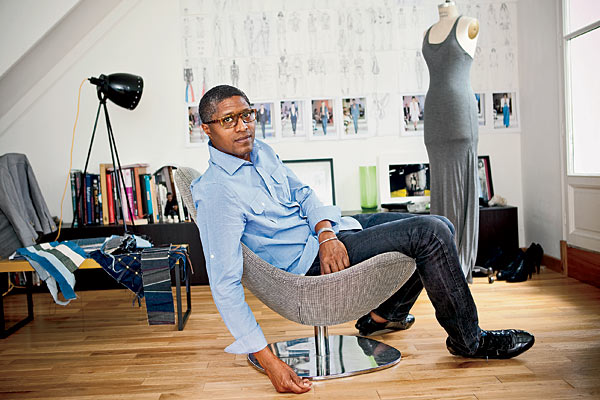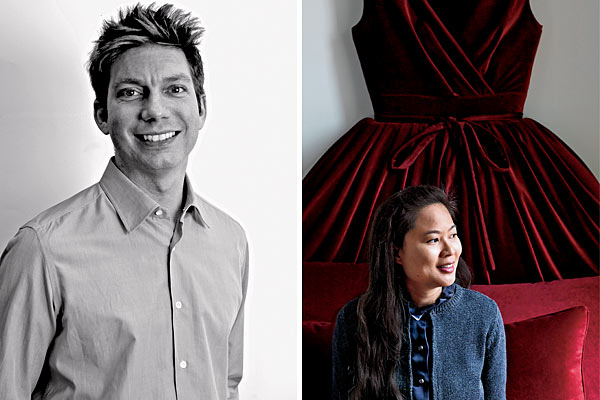
Graham in his New York studio. Photo Gallery »
The Cult Favorite: Gary Graham
At first glance, it’s hard to picture Gary Graham as anything but a polished rising star in the fashion world. “You would never know it by looking at me, but I was a goth for a long time,” the designer says. “It’s not who I am now, but there are elements of that in my work.”
One look at his luxurious collections and it’s clear what he means. Drawing on Victorian, medieval, and Gothic elements, Graham’s edgy style is an exercise in dichotomies, exploring light and darkness, romance and rebellion, the old and the new, the fantastic and the real. Finding inspiration in the historical (Ellis Island) as well as the curious (19th-century automatons), he creates stories for each of his collections and imagines how thematic threads might be woven into the clothes themselves. Whether it’s a tailored coat, a flowy dress, or a slouchy sweater, each garment is crafted using opulent fabrics and manipulated by washing and dyeing. There’s also an emphasis on versatility, with pieces having double functions. No wonder his creations are go-to pieces in many fashion-forward wardrobes.
A native of Wilmington, Delaware, Graham came to SAIC in 1988, initially studying painting and performance art before focusing on fashion design. “At that time, people were becoming art stars,” he says. He mentions Dread Scott, who set off an uproar with his controversial SAIC installation What Is the Proper Way to Display a U.S. Flag? by inviting people to step on a flag. “There was a lot of great energy.”
Graham remembers Chicago as a particularly inspiring place. He points, for example, to the music scene that featured such homegrown industrial rock bands as Ministry and My Life with the Thrill Kill Kult. But above all, it was the city’s expansiveness and lack of distraction that he found attractive. “Chicago allows you to live a little in your head because there’s a lot of space,” Graham says. “It’s nice to develop in a city that allows you to explore and figure out who you are.”
After graduating in 1992, he headed to New York City, where he worked with the SAIC alum J. Morgan Puett on her label before going solo in 1999 with his eponymous line. His early collections garnered favorable reviews, and the accolades kept coming. In 2009, Graham was named a finalist for the coveted Council of Fashion Designers of America/Vogue Fashion Fund prize, and in May he returned to his alma mater to accept the Legend of Fashion award.
As he continues to evolve, Graham insists that his aesthetic sensibility will remain constant. “My clothes determine a certain kind of woman who’s creative and independent,” he says. “Everything they put on, they put on for a reason—to tell their own story.”
Photograph: Anna Knott
Related:

The designer in his Paris studio. Photo Gallery »
The Breakthrough Artist: Earl Pickens
For the couture denim designer Earl Pickens, life in Chicago wasn’t always charmed. Growing up poor in South Side ghettos during the 1960s and ’70s, he was no stranger to the hard-knock life, having witnessed shootings and the deaths of six people. “In the 1970s, I started to really see my surroundings,” he says. “I had a unique experience.”
His journey from gang-ridden Chicago streets to his studio near the Gare de Lyon in Paris is a rags-to-riches tale of sorts, but one that’s really just beginning. Best known for his innovative streetwear and high-end denim pieces, Pickens launched his own line, Url Pickens, in 2008 and is already turning heads with his impeccably tailored collections, mostly using fine Japanese denim and modern, minimalist silhouettes to create crisp suits, flowy trousers, and fitted jackets. “I’m drawn to women’s wear that has masculine tendencies,” Pickens says. “That’s a trademark of what I like to do.”
Pickens’s dreams of entering the fashion world began when he was a small boy. In 1981, after high school, he was accepted into SAIC’s fashion program, but he dropped out on the first day. “I knew I wasn’t ready,” he says. “I needed more experience and a place where I could learn to really talk with people.”
He eventually landed a full-time sales position with David Rosenberg, a premier menswear purveyor, who mentored him and taught him how to communicate with others—a valuable skill. Pickens returned to SAIC in 1983 to complete his program, and he got his big break when he met the French designer Jean-Charles de Castelbajac, who was organizing a Beaux-Arts ball at the school in 1985. They hit it off, and Castelbajac offered the young designer an internship in Paris. Pickens, who had just won a prestigious award and $10,000 to start his own line, bought some luggage from a thrift shop, packed up all his belongings, and headed to Paris in 1986.
For the next 17 years, he worked with Castelbajac on his sportswear and accessories collections, eventually becoming the head of the studio before leaving in 2002 to work as a freelancer. In 2008, he launched his high-end line to rave reviews.
Pickens admits that although he has never looked back since leaving the South Side, he hopes to one day open a store in Chicago as an homage to the city where it all started. “It’s always been a dream to go back,” he explains. “There are people who have known you all your life and understand your struggles. So when you want to show what you’ve done, that’s the only way you can say it.”
Photograph: Ryan Robinson Assistants: Laurent Harbulot and Tommy Dutter
Related:

Bill Shapiro (left), and JoAnn Tan at Maison Moschino (right). Photo Gallery »
The Dynamic Duo: Bill Shapiro and JoAnn Tan of Moschino
The designers Bill Shapiro and JoAnn Tan didn’t know each other well at SAIC. But that didn’t stop them from becoming fast friends after meeting again halfway across the world, at the renowned fashion house Moschino in Milan. “We got to be really close,” says Shapiro. “I was even her best [man] at her wedding.”
Shapiro studied art and fashion, graduating in 1992, and landed a job as a designer at the innovative company thanks to fellow alum Lawrence Steele, who knew the brand’s iconic founder, Franco Moschino. Shapiro had been working there for little more than a year when Tan contacted him about an internship after she graduated in 1994.
“At the time, I had an ad campaign from Moschino above my desk,” says Tan, who studied animation and fashion. “So it seemed that Milan was calling.”
While Shapiro was working his way up to become an assistant to the creative director Rossella Jardini and the designer for Moschino’s main women’s and men’s collections, Tan designed the company’s Cheap and Chic line, as well as dressed its store windows. She ultimately became Moschino’s art director for retail image and special projects, focusing on window-dressing and interiors.
As for their provenance, the two couldn’t be more different. Shapiro was born in Gary, Indiana, and raised in St. Charles, Illinois; Tan was born in Malaysia and raised in Kuala Lumpur, Hong Kong, and Singapore. But both knew they were destined for careers in fashion. Growing up, Tan had always been into crafts and working with fabrics, and Shapiro expressed an interest in style at a young age. “When I was about seven, my aunt took me shopping for shoes, and I wanted white leather Nikes with a navy blue swoosh symbol,” he recalls. “I made her take me to five different stores because I couldn’t find the right shade of blue.”
They also credit their time in Chicago as essential in shaping their creative aspirations. “Schooling in Asia was all about the absorption and regurgitation of facts,” Tan says. “At SAIC, I learned to think tangentially.” For Shapiro, the school provided a creative outlet, as well as hands-on experience and enthusiastic professors. “The school gave you a lot of confidence,” he says.
Although they don’t get to work together as much as they would like these days, Tan and Shapiro have shared each other’s proudest moments. For Shapiro, it was seeing Michelle Obama photographed in various Moschino creations, including a black bow blouse when she visited the pope in July 2009. For Tan, it was completing the interiors of Maison Moschino, the company’s luxury hotel in Milan, which opened in March 2010 and features rooms with surreal touches like beds made of roses and giant cupcake pillows.
Having come a long way, both literally and metaphorically, what’s next for these intrepid designers? “More of the unexpected, I hope,” Tan quips.
Photography: Courtesy of JoAnn Tan and Bill Shapiro
Related:


